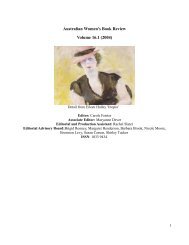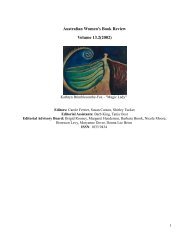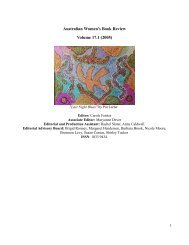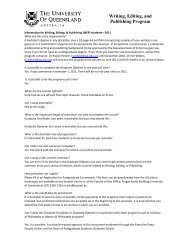Australian Women's Book Review Volume 14.1 - School of English ...
Australian Women's Book Review Volume 14.1 - School of English ...
Australian Women's Book Review Volume 14.1 - School of English ...
Create successful ePaper yourself
Turn your PDF publications into a flip-book with our unique Google optimized e-Paper software.
stories cannot be easily categorised as colonial products.<br />
Importantly, McDonald contrasts what is significant for Aboriginal adherents with what is meaningful<br />
for their pastors. For example, where Aboriginal adherents might focus on health, their pastors applaud<br />
heavenly salvation as a higher good. In the latter view, for example, healing <strong>of</strong> the body is sought not<br />
so much for the health <strong>of</strong> the adherent as to display divine power and glory. Throughout the course <strong>of</strong><br />
her book, McDonald develops a series <strong>of</strong> comparisons which distinguish Aboriginal Christianity from<br />
the experience, worldviews, and expectations <strong>of</strong> the pastors and the universalist Christianity they<br />
represent. Centrally there is the contrast, and indeed this catalyses McDonald's study, between<br />
spiritualities <strong>of</strong> place and a universalised religion <strong>of</strong> placelessness that gave meaning to displaced<br />
peoples <strong>of</strong> the first-century CE Mediterranean. McDonald also identifies other key differences between<br />
Aboriginal and traditional Christian understandings. For example, the way knowledge, spirituality and<br />
personal power is situated in the body differs: for Aboriginal adherents the 'binji', (munda), the<br />
diaphragm and stomach area is a corporeal focus which both parallels and contrasts with the Western<br />
emphasis on heart and mind (pp. 116-7). Western Christian notions <strong>of</strong> individual salvation are at odds<br />
with the values <strong>of</strong> responsibility toward one's local kinship group and country. Inter-relationships with<br />
local, protective ancestral powers, which accompany Aboriginal spiritualities <strong>of</strong> place, are at variance<br />
with a belief in a universalised and salvationary Holy Spirit power which accompanies a religion <strong>of</strong><br />
placelessness (p.103). Aboriginal and non-Aboriginal Christians model differently the relationships<br />
between the divine and the human which parallel relationships between pastors and ordinary adherents.<br />
McDonald argues that for the Aboriginal Christians she encountered the boss/worker model (drawn<br />
from the experience <strong>of</strong> station life and in which mutual obligation plays a part) prevails over the<br />
military model presented by conservative Christianity in which obedience follows command (pp. 135-<br />
8).<br />
Further, McDonald notes:<br />
The churches have been successful in suppressing traditional religious practices such as initiation<br />
ceremonies and death rituals which are expressed through performance and spectacle. They have been<br />
markedly less successful in suppressing (or appropriating) the beliefs and values which underlie these<br />
practices. Beliefs and values cannot be seen, and values in particular are rarely articulated. Both<br />
Aboriginal people and missionaries tend to interpret the other's behaviour by situating it within their<br />
own cultural context and judging it according to their own standards <strong>of</strong> appropriate behaviour. As a<br />
result, there is a great deal <strong>of</strong> unrecognised misinterpretation and miscommunication between<br />
Aboriginal people and missionaries. This protects Aboriginal beliefs and values from close scrutiny and<br />
evaluation by missionaries and other agents <strong>of</strong> change. (pp.148-9)<br />
The layers <strong>of</strong> difference, which the contrasting expectations and experience <strong>of</strong> Aboriginal and non-<br />
Aboriginal Christians represent, form the basis not only for conflict between missionaries and<br />
Aboriginal people, but also for the development <strong>of</strong> an alternative Aboriginal Christianity in which<br />
kinship responsibilities, relationship to country and the pursuit <strong>of</strong> land rights retain their salience in<br />
Aboriginal life. McDonald concludes her study: 'Rather than accepting a religion <strong>of</strong> exile (that is, a<br />
salvation religion) as compensation for dispossession and displacement, Aboriginal people in northern<br />
Australia are choosing to repossess their land instead' (p. 201).<br />
Another significant aspect <strong>of</strong> this book is the way in which it moves between McDonald's reading <strong>of</strong><br />
Aboriginal culture and experience and her consequent re-reading <strong>of</strong> the early Mediterranean and<br />
Hellenistic origins <strong>of</strong> Christianity. Methodologically this approach enriches the study by allowing the<br />
anthropological eye to turn its gaze upon the cultural foundations <strong>of</strong> Western Christianity. The final<br />
69








